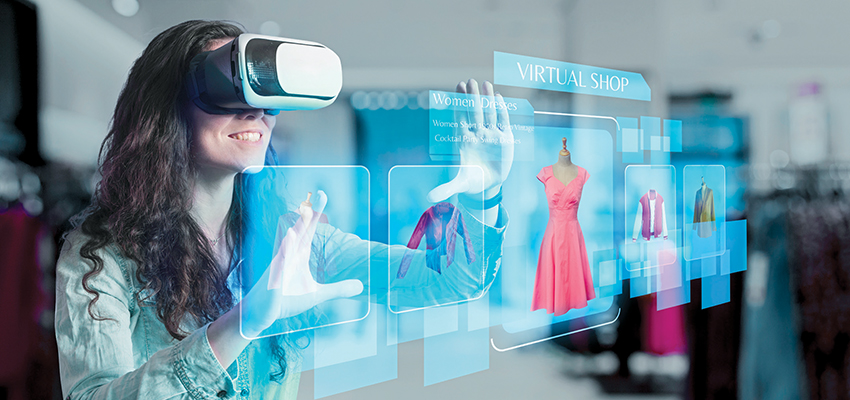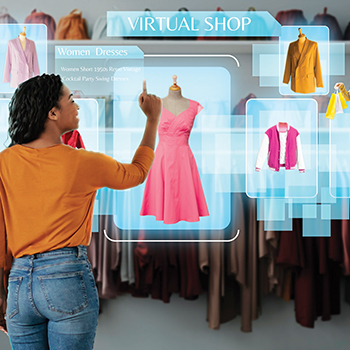Top Fashion Tech Trends 2024

If there ever was a heavenly match, the fusion of fashion and technology convinces us of its existence. This amalgamation has undoubtedly transformed the fashion industry, allowing fashion enthusiasts to soar beyond boundaries. Corporate Citizen brings to you the nine technologies in the fashion world to watch out for in 2024
We kick off this article with a compelling statistic: the fashion industry, once valued at $1.7 trillion, is projected to skyrocket to over $3.3 trillion by 2030. Over the years, we started seeing fashion in a different light, and for many, it has become a comfort zone. This industry is gearing up for exponential growth as it seamlessly integrates with technology. And now, it becomes imperative for us to maximise the potential of their merger. Let us understand how technology will revamp the fashion industry.
Artificial Intelligence (AI)
In all fairness, AI has revolutionised the fashion industry. It had a market size of $0.91 billion in 2023. This year it is expected to grow to $1.28 billion at a compound annual growth rate (CAGR) of 41.6%. AI helps the fashion industry in many ways. It aids in design creativity, analyses consumer preferences for personalised recommendations, optimises supply chains, enables virtual try-ons, detects fraud, and identifies social media trends. This year, it is projected that the fashion industry is set to maximise AI's potential.
3D Printing
Since its introduction, 3D printing has propelled the fashion market exponentially. The global market value of 3D printing in 2023 was $15 billion, projected to reach $34.5 billion by 2028. Here's how 3D printing benefits the fashion industry:
- Enables the creation of intricate, complex designs effortlessly.
- Facilitates customised clothing tailored to individual body measurements.
- Provides instant prototypes of designs, speeding up the product development process.
- Reduces material waste compared to traditional manufacturing methods.
- Offers flexibility to designers and manufacturers, allowing for agile production and experimentation.
AR-VR Fashion experiences
One of the biggest hassles while shopping for clothes is going to the mall, cutting all the traffic, and waiting in long lines at the trial rooms and then trying on clothes. With augmented reality (AR) and virtual reality (VR) fashion experiences, users can virtually try on their clothes without any hassle. The global immersive fashion market was valued at $1.9 billion in 2023 and is projected to reach $9.9 billion by 2032. Major players in this market include Gucci, Nike, Adidas, Louis Vuitton, Ralph Lauren, among others. Advantages of AR and VR Fashion experiences:
- Virtual try-on offers an immersive experience while saving time.
- People can attend virtual fashion shows from anywhere.
- Helps with customisation and personalisation of clothing items.
- Designers can use immersive tools to create visual prototypes.
- Virtual showrooms can be created where customers can explore every brand's collection.
Blockchain
Blockchain seamlessly integrates into various industries, including fashion, which involves extensive buying and selling – which indeed requires robust transactional systems. In this regard, blockchain aids in enhancing supply chain transparency. Moreover, it facilitates tracing the origins of garments, addressing the challenge of counterfeiting prevalent in the industry. Through smart contracts, it automates royalty payments to designers, simultaneously fostering consumer engagement and streamlining inventory management processes.
Mobile commerce
E-commerce has been a boon to the fashion industry but now it's time to embrace m-commerce as a necessity. The benefits of this technology are manifold:
- M-commerce offers both businesses and users unparalleled accessibility and convenience, enabling transactions anytime, anywhere.
- Users enjoy a personalised shopping experience, thanks to tailored recommendations based on their preferences and behaviour.
- With the integration of AR and virtual try-on features, users can enjoy immersive experiences, trying on clothes virtually before making a purchase.
- M-commerce provides users with multiple payment options, offering flexibility and convenience in completing transactions.
- Adopting m-commerce is not only simple but also innovative, providing businesses with a strategic edge in attracting and retaining users.
The global immersive fashion market was valued at $1.9 billion in 2023 and is projected to reach $9.9 billion by 2032. Major players in this market include Gucci, Nike, Adidas, Louis Vuitton, Ralph Lauren, among others
Sustainable tech innovation

According to a McKinsey survey, three out of five people consider whether a product affects the environment before making a purchase. This positive shift reflects growing environmental consciousness among consumers, highlighting sustainable technology innovation as an emerging trend.
- Technology has spurred creativity and curiosity in the fashion industry, leading to the development of sustainable alternatives to traditional textiles. Fabrics made from banana fibre, recycled plastic, bamboo and seaweed are just a few examples. Organic cotton and recycled polyester are also gaining popularity as sustainable choices.
- The use of 3D printing enables designers to minimise material waste, promoting more efficient and eco-friendly production processes.
- Moreover, the adoption of technologies like blockchain and supply chain management enhances transparency, allowing companies to make sustainable choices throughout their operations.
Robotics in manufacturing
Since its inception, robotics has changed the face of every industry, and its remarkable penetration into the fashion market is truly outstanding. Why is this? Because it brings so much to the table. This technology enhances productivity, efficiency, quality, precision, helps with customisation, and personalisation, and enhances creativity and innovation—the list is endless. In need of automation, which every industry requires, robotics does the needful. Robotics helps in every step, making this industry more efficient.
- As known, inventory management is tricky and time-consuming. Robotics can efficiently handle this task and make the process simple.
- Robotics can also assist in fabric testing as per given parameters
- Over the past, robotics has made the sewing process a cakewalk, and faster. They are precise and accurate.
Virtual try-on solutions
What's the first thing you look for when you buy clothes or any fashion items? It's the fit, right? When you shop online, there are times when the size won't fit you. A study shows that poor fit or bad style results in 70 per cent of people returning their items, costing businesses globally over $550 billion annually. Virtual try-on allows offline customers to try clothes, makeup, and other things digitally. It makes use of AR-VR, or computer vision technology to make this process easy. Benefits of virtual try-on:
- Reduces return rates.
- Increases sales.
- Improves customer satisfaction.
- Enhances business and brand name.
Smart fabrics and wearables
Also known as e-textiles, smart fabrics are materials that incorporate sensors, conductive threads, or electronic components directly into the fabric. These fabrics offer a wide range of functionality, detecting biometric information such as heart rate, body temperature, etc. This technology can be easily incorporated into fashion without compromising style. Although, still a fairly new technology, it has a long way to go.